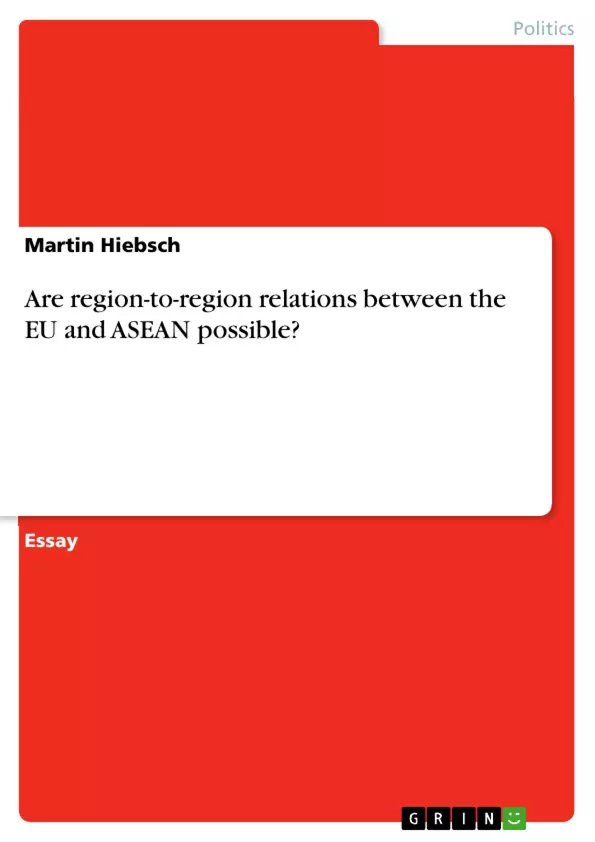The relationship between the European Union (EU) and the Association of Southeast Asian
Nations (ASEAN) is perceived as having a unique importance (Camroux 2009: 4). The first formal
meeting between ASEAN and the European Economic Community (EEC) took place in June 1972
(Lim 2012: 47) and was the first of its kind between the precursor to the EU and another regional
entity. Nowadays, the relationship is widely considered as a model for interregional relations
(Camroux 2009: 4). However, there are many obstacles impeding a further institutionalisation of the
region-to-region relations. Negotiations about the enhancement of the cooperation often have stalled
during the past decades and the progress of interregional convergence proceeds slowly.
The following essay will answer the question whether region-to-region relations between the
EU and ASEAN are possible and analyse their degree of the institutionalisation. In order to draw a
picture of the development towards interregional cooperation, the essay will summarise the
historical emergence of the relationship and identify the obstacles within the current state of
interactions. The author will present the argument that region-to-region relations are possible and
already exist. However, he will point out that, because of ASEAN's lacking capacities, the
interregional relations continue to be limited to certain fields and agreements in the economical and
political domain remain mostly bi- and multilateral. The essay will explain the structures of the
already existing interregional cooperation and stress how an enhanced relationship would be
beneficial for both organisations. Finally, it will summarise its findings and provide an outlook for
the years to come.
Inhaltsverzeichnis (Table of Contents)
- Historical emergence of the EU-ASEAN relationship
- The defensive attitude towards ASEAN changed with the influence of the globalisation process and the rising opinion that regionalism could be an instrument to adapt and promote global cooperation
- Obstacles within the current cooperation
- Both organisations constitute mechanisms for integration in their regions, but differ in several key aspects like the degree of their institutionalisation
- Even though ASEAN appreciates the benefits of the interregional relations with the EU and is not averse to a further convergence of the two regions, there are still significant differences between ASEAN member states and the EU regarding issues such as the protection of intellectual property and investment
- In the 1990s, the EU introduced the promotion and protection of human rights into the ASEAN-EU relationship
- The launching of the Asia-Europe Meeting (ASEM) threatened the importance of ASEAN
- For enhanced region-to-region relations it is important to develop a common European policy towards all of Southeast Asia
- Soft power resources like economical and financial aid make the EU an essential partner in the region
- There seems to be reluctance within ASEAN to negotiate and implement an FTA agreement with the EU
- Another question is, whether interregional cooperation may be hampered by the different social and political circumstances within the regions
Zielsetzung und Themenschwerpunkte (Objectives and Key Themes)
This essay explores the possibility of region-to-region relations between the European Union (EU) and the Association of Southeast Asian Nations (ASEAN). It examines the historical development of their relationship and the obstacles hindering further institutionalization. The essay argues that while region-to-region relations are possible and already exist, they are limited due to ASEAN's lacking capacities. Key themes include:- The historical emergence of the EU-ASEAN relationship
- Obstacles to further institutionalization of interregional relations
- The role of globalisation and regionalism in shaping the relationship
- The differences in institutional structures and levels of integration between the EU and ASEAN
- The potential for enhanced cooperation in economic and political domains
Zusammenfassung der Kapitel (Chapter Summaries)
The essay begins by outlining the historical development of the EU-ASEAN relationship. It highlights the initial formal meeting in 1972 and the subsequent evolution of the relationship, emphasizing the impact of global events and the varying political climates of both regions. The essay then delves into the obstacles hindering further institutionalization of the EU-ASEAN relationship. It contrasts the supranational nature of the EU with ASEAN's more multilateral approach, discussing the implications for interregional cooperation. Key differences in regional integration strategies, national sovereignty issues, and varying priorities regarding human rights are also discussed. The essay examines the role of the Asia-Europe Meeting (ASEM) in the context of EU-ASEAN relations, highlighting the potential for marginalization of smaller ASEAN states within a larger framework. It also discusses the EU's capacity to implement policies across an integrated region, contrasting this with ASEAN's need for EU support in translating ideas into policy.Schlüsselwörter (Keywords)
The main keywords and focus topics of the text revolve around the EU-ASEAN relationship, encompassing concepts of regional integration, interregional cooperation, institutionalization, and the interplay of economic, political, and security interests. Other key terms include globalisation, regionalism, supranationalism, multilateralism, human rights, and free trade agreements. The essay explores the challenges and opportunities inherent in building a stronger and more comprehensive partnership between these two important regional blocs.- Quote paper
- Martin Hiebsch (Author), 2013, Are region-to-region relations between the EU and ASEAN possible?, Munich, GRIN Verlag, https://www.grin.com/document/271877



